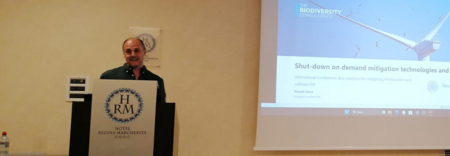Shutdown on Demand: Reducing Bird Fatalities at Wind Farms
As the world races to address the climate and biodiversity crises, the transition to renewable energy is accelerating rapidly, and wind energy projects are proliferating worldwide. According to the International Energy Agency, by 2025, renewable energy is set to overtake coal as the largest source of global electricity generation. At the climate COP28 at the end of 2023, nearly 200 governments agreed on the need to triple global renewable energy capacity by 2030 to meet climate targets. Wind energy is key to this. Global cumulative wind power capacity passed the first 1 TW milestone in 2023, and according to the Global Wind Energy Council’s Global Wind Report 2024, 791 GW of new wind capacity is likely to be added in the next five years.
It is essential that the renewable energy transition is nature safe. There is potential for wind farms to have adverse impacts on biodiversity, including collision risk impacts on bird species. Mitigating these impacts starts with the appropriate siting of wind farm projects in locations where impacts can be avoided entirely (i.e., away from migratory corridors, roosting sites, or near breeding and foraging areas). After avoidance, shutdown on demand (SDOD) is considered the most effective mitigation approach for reducing bird collisions. SDOD has advantages and some challenges, especially for offshore wind developments.
How Shutdown on Demand works
SDOD is the temporary stopping of wind turbine blades in response to the presence of at-risk species or to high numbers of birds at risk. Large soaring birds like vultures and other birds of prey, and migratory species like gulls and terns offshore, are especially susceptible to collision. Collision risk is highly site-specific and depends on project characteristics like layout and turbine blade tip height, and environmental variables including species abundance and behaviour, and prevailing weather conditions.
Initially, SDOD relied on human observers to spot at-risk birds and communicate with the wind farm operators, who would then shut down the turbines. SDOD is now increasingly technology-assisted, using radar, camera systems, GPS transmitters, geofencing technology, and artificial intelligence (AI) to detect birds' movements in real-time.
In some cases, SDOD can be a combination of both human and technology assisted, where detection is made by observers supported by radars (for example). Using this information, the final decision to stop turbines is taken by wind farm personnel who then manually implement shutdown.
Effectiveness of SDOD at onshore wind farms
After site selection, SDOD is recognised as the most effective method for minimising bird fatalities at wind farms, particularly when the turbine layout has been optimised. Many wind farm operators now incorporate SDOD into their project mitigation strategies to meet Environmental Impact Assessment and lender-finance requirements.
Studies have demonstrated the effectiveness of SDOD, showing reductions in bird fatalities for target species ranging from 50% to nearly 100%. For example, Griffon Vulture mortality was reduced by 92.8% with a minimal loss of energy production (less than 0.5%). Similarly, SDOD has led to an 85% reduction in fatalities among Bald Eagles and Golden Eagles, while another example reports up to a 63% reduction in Golden Eagle fatalities.
One notable example of the successful use of SDOD is the Kipeto Wind Farm in Kenya. Since 2017, with the support of The Biodiversity Consultancy, Kipeto has operated with a commitment to achieving No Net Loss of some raptor species, including Critically Endangered vultures. A protocol was established to shut down turbines when at-risk species such as the Ruppell’s Vulture, were detected. In 2022 alone, the wind farm implemented 1,023 shutdowns, with 81% of these triggered in response to priority vulture species. As a result, the Kipeto project has averaged only 0.03 priority species fatalities per turbine per year, earning the project international recognition for biodiversity management.
Challenges and Opportunities for Offshore Wind Farms
While SDOD has been successfully implemented onshore, expanding its use to offshore wind farms presents some difficulties. Human observation is impractical in offshore environments, making radar and camera-based systems the primary focus.
The challenges offshore wind farms are likely to face in using SDOD include:
-
Technologies will need to be highly reliable and be able to withstand much harsher conditions than onshore, because maintenance access offshore is limited.
-
Some of the highest risk situations for birds will often occur during higher wind speeds, waves and rain - the worst detection conditions for camera and radar.
-
Technologies will need to be able to detect seabirds against a noisy background of waves, with camera systems equipped with AI detection that needs to be trained to detect priority seabird species.
-
Turbine movement in floating offshore wind farms may worsen radar and camera performance compared with stationary platforms.
While in time, technological advances could overcome many of these challenges, there may still be opportunities to implement shutdowns in certain conditions and seasons with high levels of bird or (bat) migration through an offshore area.
As the renewable energy sector continues to grow and technology develops, SDOD will likely play an increasingly important role in balancing energy production with biodiversity conservation.
For wind farm operators looking to implement biodiversity-friendly solutions, SDOD offers a practical, proven method to meet both environmental and financial requirements, ensuring a greener and more sustainable future for all.
The Biodiversity Consultancy combines years of experience and expertise in implementing biodiversity risk assessment and SDOD mitigation approaches for wind farms, remaining at the forefront to guide on understanding and addressing the challenges.
Categories: Renewable Energy, Insight, Biodiversity Strategy, No Net Loss and Net Positive Impact
Make Nature Your Business
Find out how you can make nature your business.


